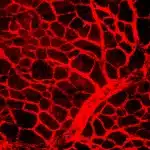A compound produced by a pregnant lizard may provide important information on the origins and treatment of cancer in humans, according to zoologist Bridget Murphy from the University of Sydney, who discovered the protein, which is pivotal to the development of the lizard placenta.
“Our egg-laying ancestors probably never got cancer, but things changed when we started having live young. Embryos need an extensive network of blood vessels to allow them to grow. So do tumours. I found that the three-toed skink, which gives birth to live young, uses a particularly powerful protein to encourage the growth of blood vessels. The only other place where this protein has been found is in pre-cancerous cells grown in the laboratory,” she says.
Future research on unlocking the secrets of how the protein works might well provide the basis of new therapies for cancer, and to promote wound healing or the regeneration of blood vessels in patients with heart disease. Bridget’s work is being presented for the first time in public through Fresh Science, a communication boot camp for early career scientists held at the Melbourne Museum. She was one of 16 winners from across Australia.
The protein belongs to a group known as vascular endothelial growth factors (VEGFs) which help to produce blood vessels in the uterus during pregnancy. Bridget became interested in the group as part of a study of the evolutionary origins of live birth.

The same protein found in pre-cancerous skin cells helps blood vessels to grow in the placenta of the three-toed skink (photo: Nadav Pezaro)
“Both tumours and embryos must develop an extensive network of blood vessels which bring in oxygen and nutrients to allow them to grow,” Bridget says. “And they both must avoid rejection by hiding from the immune system of their host. In fact, many researchers think that cancers have hijacked the molecular machinery that originally evolved to allow embryonic development.
“It may be that animals that give birth to live young, such as humans and some lizards, have an increased susceptibility to cancer.”
Using techniques to measure which of the VEGF genes were present and active in lizards, Bridget discovered the first known natural source of VEGF111 in the three-toed skink (Saiphos equalis), a shy Australian lizard which lives underground.
Bridget Murphy is one of 16 early-career scientists presenting their research to the public for the first time thanks to Fresh Science, a national program sponsored by the Australian Government. Her challenges so far have included presenting her discoveries in verse at a Melbourne pub.
For further information, contact Bridget Murphy at bridget.murphy@sydney.edu.au
ADDITIONAL IMAGES









 Fresh Science is on hold for 2022. We will be back in 2023.
Fresh Science is on hold for 2022. We will be back in 2023.